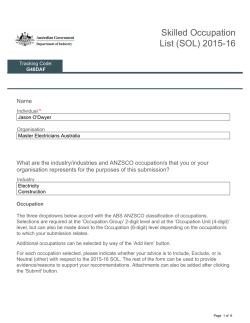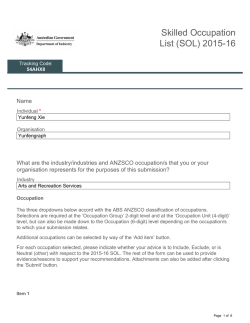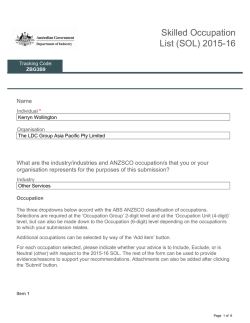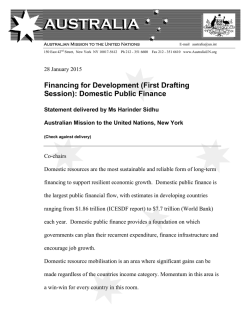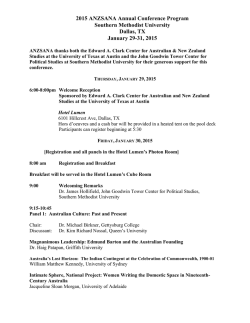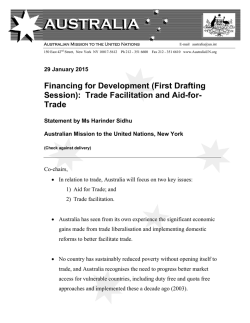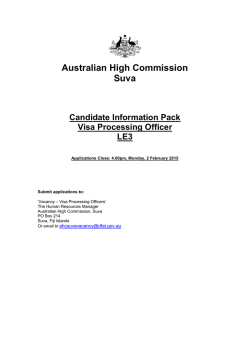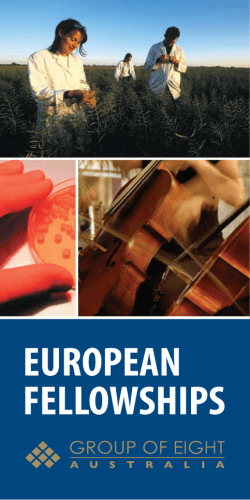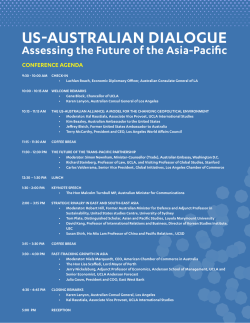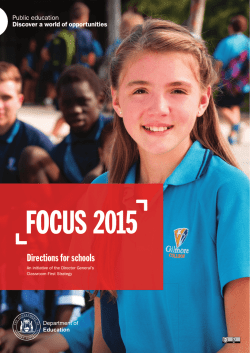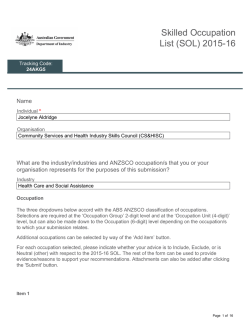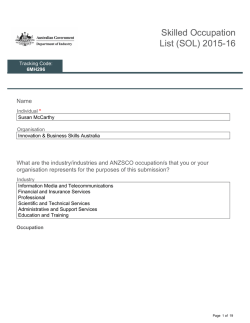
Skilled Occupation List (SOL) 2015-16
Skilled Occupation List (SOL) 2015-16 Tracking Code: T43RA4 Name Individual * Ms Kym Daly Organisation Australian Association of Social Workers (AASW) What are the industry/industries and ANZSCO occupation/s that you or your organisation represents for the purposes of this submission? Industry Professional Education and Training Health Care and Social Assistance Other Services Occupation The three dropdowns below accord with the ABS ANZSCO classification of occupations. Selections are required at the ‘Occupation Group’ 2-digit level and at the ‘Occupation Unit (4-digit)’ level, but can also be made down to the Occupation (6-digit) level depending on the occupation/s to which your submission relates. Additional occupations can be selected by way of the ‘Add item’ button. For each occupation selected, please indicate whether your advice is to Include, Exclude, or is Neutral (other) with respect to the 2015-16 SOL. The rest of the form can be used to provide evidence/reasons to support your recommendations. Attachments can also be added after clicking the 'Submit' button. Page 1 of 7 Item 1 Occupation Group * Legal, Social and Welfare Professionals Occupation Unit * Social Workers Occupation Social Worker 272511 Summary advice for 2015-16 SOL * Include Exclude Neutral Are there any occupations that you represent where there is evidence of imbalances in the demand for and supply of skills in the medium-to-long term? * Demand for social workers is expected to continue to grow as per the Australian Government Job Outlook projections. (http://joboutlook.gov.au/occupation.aspx? search=keyword&tab=stats&cluster=&code=2725) The following is a snapshot of the job prospects for Social Workers as reported on Job Outlook: Indicators Level for Social Workers How does unemployment (for Social Workers) compare with other occupations? Below average What has been the long-term employment growth - 10 years (%)? 158.4% What has been the medium-term employment growth - 5 years (%)? 82.9% (compared to 6.5 for other occupations) What has been the short-term employment growth - 2 years (%)? 57.4% (compared to 1.9% for other occupations) What will be the likely future employment growth for the next five years? Strong growth Social work is an ageing profession, which will continue to impact on the supply of Social Workers in Australia. According to the Australian Government Job Outlook data, 44% of those who identify as being a Social Worker are aged 45+. This ageing of the profession is also reflected in the AASW membership profile with 58% of our members being over 45 years of age Page 2 of 7 and 3.5% of these members are fully retired. Social work is also a profession which is female dominated. According to our membership statistics 79% of our members are female. Further, the Australian Government Job Outlook figures indicate that there is a shortage of qualified social work professionals to meet workforce demand. The figures indicate employers are being required to recruit staff with lower qualifications. For example, the Job Outlook figures show that 28.2% of people employed as social workers have qualifications lower than the minimum educational attainment of a four year AASW accredited Bachelor of Social Work or a relevant three year undergraduate degree followed by a two year AASW accredited Master of Social Work. These figures are also supported by research conducted by Karen Healy and Bob Lonne in their publication, 'The social work and human services workforce: Report from a National Study of Education, Training and Workforce Needs’, which summarises some of the key issues for the social work and human services workforce into the future to be: • “An undersupply of professionally qualified social work and human services workforce to meet work force demands • Rapid ageing of the workforce with many workers approaching retirement • Limited career and salary structures creating disincentives to retention • A highly diverse qualifications base across the workforce. This diversity is inconsistent with the specialist knowledge and skills required of practitioners in many domains of community service provision” (Healy & Lonne, 2010, Pg 5) It is critical for the protection of the public and the upholding of professional standards that people employed in Social Worker jobs hold the minimum educational attainment of a four year Bachelor degree or equivalent, and that employers are not forced to recruit staff to social work positions that have lower qualifications and/or qualifications from a different field. In the 2013/14 financial year, the Australian Association of Social Workers received 352 applications for overseas qualifications assessments. This represented an approximately 10% increase on the number of applications received in 2012/13 (317 applications). The most common countries of social work training outside Australia were the United Kingdom, New Zealand, Ireland, India, USA, South Africa and Canada. There has also been a steady increase over the past several years in the number of internationally qualified social workers who are applying to have their overseas qualifications assessed for AASW membership eligibility purposes only (that is, they have not sought a migration skills assessment). In 2013/14, 121 applicants applied for an AASW membership eligibility assessment only, which represented a 24% increase on the number of applications (91) received in 2012/13. In 2011/12, 70 applications were received for membership eligibility assessment (23% increase on previous year). While an AASW membership eligibility assessment is a separate process to a migration skills assessment, the increasing number of social workers seeking AASW membership eligibility is a further indication that internationally qualified social workers are in demand in Australia, as Page 3 of 7 AASW membership eligibility is increasingly the benchmark for social work employment in Australia. Is there evidence of imbalances in the demand for and supply of skills in the medium-to-long term in non-metropolitan areas? If so, can you indicate in what part of Australia and the number in the occupation in over or undersupply. A 2013 survey of AASW Accredited Mental Health Social Workers (AMHSW) found that the practice locations of Social Workers were slightly higher in regional and remote areas than the general population distribution. Geographic location of AMHSWs practice by % AMHSW responses and ABS population data Answer Options % AASW Response ABS % population distribution data 2009 Major City (inner & outer) 59.7 64 Regional Australia (inner & outer) 36.1 33.7 Remote and very remote Australia 4.1 2.3 Australian Association of Social Workers, 2014, Submission to The Hon Peter Dutton MP, Minister for Health Re: Rebate equity for Accredited Mental Health Social Workers to that of Registered Psychologists providing clinical interventions under Medicare Australia’s ‘Better Access’ program. http://www.aasw.asn.au/document/item/6329 The AASW runs Horizons Career Centre which among other services has a facility whereby employers can advertise jobs. Of the 328 social work job advertisements placed in 2013/14, 219 were in capital cities. 109 were in regional areas of Australia. Thus 33% of the social work positions advertised were for positions outside the capital cities. This is a significant proportion of the total positions advertised. Are there any occupations which require formal licensing or registration arrangements in order to practice/perform in this occupation? For example: • Midwives are required to register with the nurses board in their state or territory • Panelbeaters are required to be registered or certified with the state Motor Vehicle Repair Industry Authority Social work, in Australia, is currently a self-regulating profession with no formal licensing arrangements. Page 4 of 7 The AASW is the standard setting body for social work in Australia and eligibility for AASW membership is the benchmark for employers seeking to employ Social Workers. Further, in 2013/14 the AASW developed a new credentialing process for employers, with the introduction of an Accreditation program for professionally qualified Social Workers in Australia. AASW Accredited Social Workers can identify as such by displaying a legally protected trade mark logo. AASW Accreditation confirms for employers, the public and others that a Social Worker has: • A legitimate professional qualification in social work • A positive assessment of their overseas social work qualification to confirm Australian equivalency, and confirmation of English language skills, where applicable • Accountability to the AASW Code of Ethics • Completed the minimum amount of annual continuing professional development • A recognised professional credential to provide Medicare and other Government funded mental health services, where applicable • Current professional indemnity and public liability insurance coverage The AASW Accredited Trade Mark registration is increasingly becoming the standard sought by employers. As at 30 June 2014, the Australian Association of Social Workers (AASW) had 7,854 members nationwide. The objectives of the AASW are to: • to promote the profession of social work; • to enhance the public and professional recognition and identity of social work; • to establish, monitor and improve practice and ethical standards; • to contribute to the development of social work knowledge and research; • to develop, review and accredit the education standards for social workers; • to advocate for the pursuit of social justice and changes to social structures and policies in order to promote social inclusion and redress social disadvantage; • to promote and facilitate members’ professional development and life-long learning; and • to represent and advocate for the interests of members as a group. Is it expected that your employment sector will be impacted by any medium-to-long term trends which will impact upon demand and/or supply (excluding costs associated with training, labour hire, and international sponsorship)? Please provide evidence (e.g. data source, policy document) which substantiates these claims. Page 5 of 7 For example: • New benchmarks for childcare centres mandate increased staff-to-child ratios and higher qualification standards for childcare workers. As per the Australian Government Job Outlook figures, strong future employment growth is projected for Social Work in Australia over the next five years. It is expected that strong demand (that is, strong employment growth and below average unemployment for Social Workers, coupled with an ageing Australian social work workforce), will continue to impact upon the supply of an Australian Social Work workforce in the medium to long term. Please provide any other information you consider relevant evidence to support your submission For example, you may know of some independent studies about your occupation that supports your advice to us. A professional social work qualification in Australia requires the completion of either a four year Bachelor Degree in Social Work or a relevant undergraduate degree followed by a two year Master of Social Work. Would you like to make any additional comments on the SOL? The AASW has continued to experience a steady increase in the number of applications for migration skills assessments in the past several years. In 2010/11 we received 154 applications for migration skills assessments; in 2011/12 we received 214; in 2012/13 we received 226; and in 2013/14 we received 231 applications. Please provide the name, position and contact details of a person within your organisation who is willing to be contacted if any further information or follow-up is required. Name * Ms Kym Daly Position * Senior Manager Professional Standards, AASW Page 6 of 7 Contact details * PO Box 2008 Royal Melbourne Hospital VIC 3050 T: 03 9320 1066 E: [email protected] All information, including name and address details, contained in submissions will be made available to the public on the Department of Industry website unless you indicate that you would like all or part of your submission to remain in confidence. Automatically generated confidentiality statements in emails do not suffice for this purpose. Respondents who would like all or part of their submission to remain in confidence should provide this information in an email to SOL@industry. gov.au . Legal requirements, such as those imposed by the Freedom of Information Act 1982, may affect the confidentiality of your submission. Page 7 of 7
© Copyright 2026
